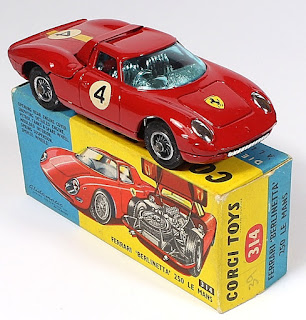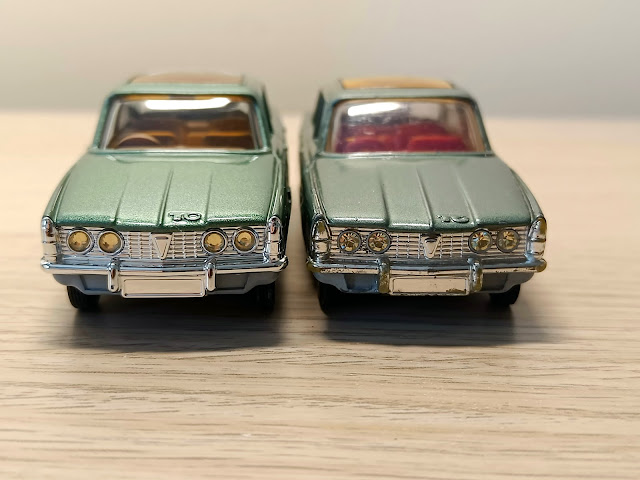As I started to write in my last article, I am attempting to resist starting to collect some of what I call Corgi's 'later models'. These are the issues from around 1969 through to the company going into receivership at the end of 1983. They cover a multitude of categories: lots of racing cars, aircraft, film and TV character vehicles, space and military vehicles and, of course, the 1:36 scale models, none of which I have found particularly interesting in the past.
The larger scale models always appear rather cheaply finished and lack the charm and sense of quality of so many of the earlier issues. The aircraft look quite impressive but I'm not really interested in them and I certainly have no time for the film and TV stuff. So it has been relatively easy to ignore all the issues so far.
I have, however, always wanted a decent list to consult as people do ask questions from time to time about the later issues and I cannot help being slightly intrigued when I see a range of what appear to be different Rover 3500s or some other models on Ebay. I do like variations. It all started with the British Machin definitive stamps, for which the first denominations were issued in 1967. As new values were issued and postage rates changed over time, there have been over 1000 different 'varieties' of these stamps with the Arnold Machin design of HM Queen Elizabeth II's head. I was 15 in 1967 and was able to afford to start and, once employed, able to continue, acquiring all these varieties through to the end of the series just a short time ago.
So, just as I created a list of those, I did the same for my second hobby, Corgi Toys from 1956-70s and now feel that one is needed for the later models. There is nothing that I found of much use online. Marcel Van Cleemput's Great Book of Corgi does tell us more or less what was issued when but it's not an easy reference book. The little red book that accompanied it is more readily consulted but what we really need these days is something online that appears when we need it.
By chance I have had some correspondence on another matter with a collector called Daniel Feuchtwanger who is based across The Pond in the Bronx.
Mr Feuchtwanger had built a lovely Excel spreadsheet of the whole Corgi shooting match from 1956 to 1983 and has been kind enough to permit me to work with this. It was not as vast as you might think because he has been concerned only with the different catalogue numbers, not variations of models. So there is just the one 286 Jaguar XJ12 whereas I have seen at least 3 different colours and suspect there may be more.
This is a great start for me, though, as he has been very thorough and precise and it is a far better resource for this task than anything else I have found. Firstly I extracted all the earlier items and some later issues in 1:43 scale, basically all the items that I have already listed myself. Next I put his data into the same format as I have used for my other lists just to make everything a little more consistent and added a few models that I found referred to in the Little Red Book and which I feel need to be included until I can determine that they were either not actually issued or were errors (and there are plenty in that book to watch out for!) The time-consuming part was adding months, missing from my colleague's list, but which were mostly available in the Little Red Book.
The end result is a nice clean list that may be useful to someone and it is now available to view on my Catalogue website
at this link. I have listed the data in three ways, by Catalogue number, by issue date and by model name.
Now I can get back to what I started to say in the previous article. This exercise has left me needing to find those varieties. I have become intrigued and models like the Jaguar and Rover seem to have a lot of different issues that I need to add to the list. I am hoping that this will not be a massive task, and, from a first glance at what appears to be on sale, the variations are going to be colours or some promotional stickers in the main. All the cars seem to have the same wheels! I am sure I will discover that they don't really but they certainly appear that way. It's only the cars that I am going to look at first. I have a feeling that most, if not all, of the other categories will be single items, especially those issued shortly before closure of operations when there would not have been time for many changes.
What is interesting to me now is just how chaotic life appears to have got at Corgi in 1982 when, even if the staff didn't know, the managers were clearly aware that they needed to sell a lot more to try to survive and so umpteen gift sets were created and these may well have had slight variations on the previously issued model. It looks like Woolworths and Marks & Spencer also were selling packs produced specially for them and that could provide some new material too.
At the moment, many of these models are going for a song, making very low prices if selling at all. They're not popular at the moment but I remember how Whizzwheels models were cheap and cheerful not long ago until someone realised that there weren't many of some of them and most now fetch high prices, as much or more in many cases than the original model on which they were based. I don't know whether the same will apply to the 1:36 series but if I am going to take a closer look I'll need to buy some and this may be as good a time as any.
So it does look as though I shall not be able to resist the temptation and will be getting some 1:36 cars. I don't see many so it shouldn't cost a fortune unless there really are some scarce ones.
I'm going to set a limit of £10, though, which is what I did for the British (up to 1999) Vanguards as a little much-needed discipline. It means I will not get boxes but they're pretty grotty boxes from what I can see anyway with something of a gamble as to which was actually issued in which in the later years. I am also having to contend with what look like very similar models made in the later 1980s and 1990s, just to confuse matters. And I may change my mind as I can see it will be damn difficult selling anything again unless I am very lucky and get some of the scarcer issues at that price.


































